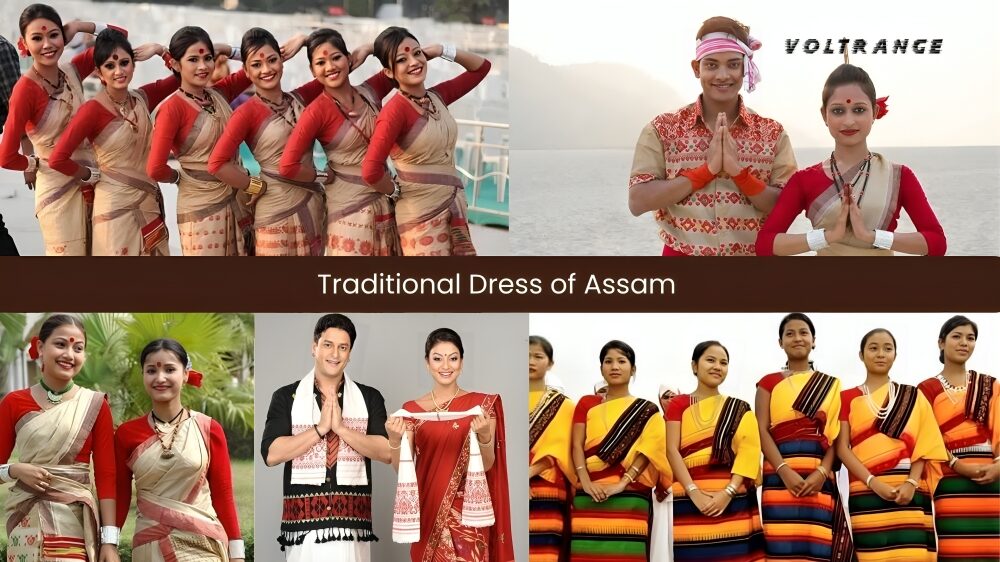
Traditional Dress of Assam
In the northeastern corner of India lies Assam, a state renowned for its diversity, beauty, and deep cultural roots. The traditions of Assam are reflected not just in its way of life but also in the clothing worn by its people. Over the centuries, the people of Assam have preserved their culture with great care, passing it down through generations. From the distinctive Mekhela Chador to the symbolic Gamocha, the traditional attire of Assam tells a story of heritage, craftsmanship, and pride. Let’s explore these garments and their significance for both men and women.
Traditional Attire for Men in Assam
The clothing of Assamese men is a blend of simplicity, practicality, and elegance, deeply rooted in the region’s cultural identity. Here are some key elements of Assam’s traditional male attire:
1. Dhoti
The Dhoti is a classic garment for men in Assam, offering both comfort and functionality in the region’s humid climate. It’s a long rectangular cloth wrapped around the waist and legs, showcasing the versatility and craftsmanship of Assamese weavers. Whether plain or adorned with vibrant motifs, the Dhoti is a timeless piece that connects modern Assamese men with their cultural heritage. Paired with a kurta or shirt, the Dhoti is more than just attire—it’s a symbol of tradition, history, and cultural pride.
2. Kurta
For men in Assam, the Kurta is a garment that exudes elegance and cultural significance. Made from cotton or silk, the kurta is a long tunic with intricate embroidery along the neckline, cuffs, and placket. These embellishments are a testament to Assamese artistry. Whether in muted earthy tones or bold colors, kurtas are suitable for a variety of occasions, from casual outings to formal gatherings, allowing men to express their style while embracing tradition.
3. Gamocha
A quintessential symbol of Assamese culture, the Gamocha is a rectangular piece of cotton cloth known for its unique patterns and multipurpose use. It serves as a towel, a headgear, or even a token of respect during ceremonies. The Gamocha represents much more than its practical uses; it is a cherished cultural artifact that symbolizes honor, hospitality, and the deep-seated values of Assamese society.
4. Jorhat Topi
The Jorhat Topi is a conical hat made from bamboo and cane, skillfully crafted by Assamese artisans. Often adorned with vibrant threads and intricate designs, the Jorhat Topi is worn during important cultural events and festivals. Beyond its decorative function, the topi is a powerful symbol of Assamese identity, representing the region’s artistic heritage and communal values.
Traditional Attire for Women in Assam
Assamese women’s traditional clothing is a blend of grace, artistry, and timeless beauty. Each garment holds cultural significance and showcases the intricate craftsmanship of the region. Here’s a closer look at the traditional attire of Assamese women:
1. Mekhela Chador
The Mekhela Chador is the most iconic garment worn by Assamese women. This two-piece outfit is a symbol of Assamese culture and artistry. The Mekhela forms the lower half of the ensemble, resembling a skirt that drapes around the waist, while the Chador is a long piece of fabric worn over the upper body. Usually made from silk or cotton, this attire is adorned with intricate patterns and designs that reflect the region’s traditions and folklore. The Mekhela Chador stands as a testament to the artistry and creativity of Assamese weavers.
2. Riha
The Riha is an elegant blouse often paired with the Mekhela Chador. Made from silk or cotton, it features delicate embroidery on the neckline, sleeves, and hem. The Riha is more than just a garment—it’s a reflection of Assamese women’s rich fashion heritage, combining traditional craftsmanship with an aesthetic that has evolved over time. Its intricate designs and various styles make it a versatile piece for both casual and formal occasions.
3. Assam Silk Saree
Assam is renowned for its exquisite silk, and the Assam Silk Saree is a beloved garment among Assamese women. Known for its luxurious texture, vibrant colors, and intricate motifs, the Assam silk saree is reserved for special occasions and celebrations. Handwoven by skilled artisans, each saree is a masterpiece that highlights the region’s rich tradition of silk production, with designs that often include motifs of nature, animals, and cultural symbols. It’s a garment that celebrates both elegance and heritage.
4. Japi
The Japi, a conical hat made of bamboo and cane, is traditionally worn by both men and women during festivals and cultural events. For women, wearing the Japi adds an extra layer of cultural significance to their attire. Embellished with bright threads and intricate designs, the Japi symbolizes unity, celebration, and a deep connection to Assamese tradition. It’s more than just a headgear; it’s a representation of the wisdom and cultural knowledge passed down through generations.
Conclusion
Assam’s traditional attire is a living embodiment of the region’s rich cultural history and artistic craftsmanship. The carefully woven fabrics, intricate designs, and symbolic garments speak volumes about the values, traditions, and identity of the Assamese people. Whether it’s the timeless elegance of the Mekhela Chador or the symbolic significance of the Gamocha, each piece of clothing tells a story of tradition, creativity, and pride. In Assam, culture is not just preserved—it’s celebrated in every thread and stitch.





More Stories
which of the following statements is true about education and lifetime earnings? Complete Guide Here
Statekaidz.com: Education with Fun For Kids 2025
Top 5 Richest States in India by GDP